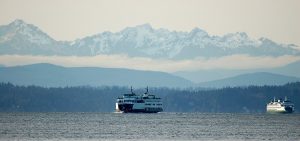March 6, 2023
The two WSG-led projects selected for funding will focus on sea level rise vulnerability and managing invasive European green crab

Photo: Grace Marcella Norman
Two projects led by Washington Sea Grant (WSG) will receive a total of $1.59 million through the Puget Sound National Estuary Program’s Habitat Strategic Initiative, a partnership between Washington Department of Fish and Wildlife and Washington Department of Natural Resources. The WSG-led projects will focus on sea level rise vulnerability and on managing invasive European green crab, which will receive $798,785 and $794,789 in funding respectively. In addition, WSG is a partner on a third project led by the University of Washington School of Aquatic and Fishery Sciences, which will receive $797,256 to monitor the impacts of shoreline restoration efforts.
In total, the Habitat Strategic Initiative Leads chose 25 projects in which they will invest approximately $14 million to advance Puget Sound habitat recovery. The projects will advance protection efforts to restore eelgrass habitat and enhance kelp forest conservation; expedite floodplain and estuary restoration projects; and provide incentives to private landowners to improve habitat along shorelines and streams and in working farms and forests. Projects will also provide information and tools to increase resiliency for people and habitat to climate change and assist local governments with land-use planning efforts to protect habitat and integrate nature-based solutions.
Investments are distributed across five investment priorities: changing planning paradigms, supporting project development and readiness, behavior change, regulatory support, and information and evaluation. These five investment priorities represent a systems approach and holistic vision for habitat investment in Puget Sound to achieve multiple outcomes for streams and floodplains, forests and wetlands, estuaries and beaches and marine vegetation.
Learn more about the three selected projects for which WSG is the lead or partner.
Assessing parcel-scale sea level rise vulnerability
Project lead: Ian Miller, Washington Sea Grant
WSG and partners will use this funding to implement the second phase of a project that assessed sea level rise vulnerability across about 111,000 parcels in Puget Sound (learn about phase one). The new phase will expand the footprint of the research west to the mouth of the Strait of Juan de Fuca, recalculate the sea level exposure and vulnerability for the entire study area, and make the results available in an online interactive format. The results will inform future efforts around habitat restoration, land use and hazard mitigation planning.
Coastal habitat protection through European green crab early detection, management support and monitoring
Project lead: Emily Grason, Washington Sea Grant
Preventing risk of significant harm to critical Salish Sea nearshore habitats species at the claws of dense populations of the omnivorous, aggressively burrowing European green crab is the primary goal of WSG Crab Team’s monitoring network, management support and outreach. Funding for this project will be used to 1) maintain Crab Team’s critically important core early detection and monitoring network, 2) enhance Crab Team’s ability to provide scientific expertise to partners in green crab response and management in Washington and British Columbia and 3) enhance both public engagement and early detection with a new early detection program area focused shoreline surveys for crab molts. In addition to early detection, collected data and products will continue to serve the systematic, long-term monitoring of crabs and fish in important and often under-monitored Salish Sea pocket estuaries and other nearshore habitats.
Using the Shoreline Monitoring Database to evaluate restoration and protection efforts
Project lead: Jason Toft, UW School of Aquatic and Fishery Sciences
The Shoreline Monitoring Database provides standardized approaches to monitor shorelines in Puget Sound. With this funding, the team will add additional years, locations, and types of monitoring at fish and wildlife habitat sites to the existing database so they can analyze those data to provide priorities and guidelines for improved implementation of future habitat protection and restoration. This work will address knowledge gaps by 1) increasing the spatial scale of additional restored and protected sites with a focus on armor removal and natural functions, allowing for analysis of these data in the context of spatial factors such as proximity to urban development and sea level rise, and (2) increasing the temporal scale of monitoring before and after restoration by including sites with ongoing monitoring for over 10 years, thus allowing for analysis of long-term trends that can inform management goals.
Learn more about selected projects from Washington Department of Fish and Wildlife.
###
Washington Sea Grant, based at the University of Washington, helps people and marine life thrive through research, technical expertise and education supporting the responsible use and conservation of coastal ecosystems. The National Sea Grant College Program is part of the National Oceanic and Atmospheric Administration, U.S. Department of Commerce.
www.wsg.uw.edu.
Join the conversation: @WASeaGrant and Facebook.com/WaSeaGrant.
MAR
2023